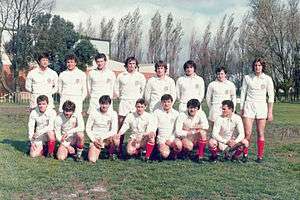Rugby union in Yugoslavia
| Rugby union in Yugoslavia | |
|---|---|
|
Coat of arms of the SFRY | |
| Country | Yugoslavia |
| National team | Yugoslavia |
National competitions | |
Club competitions | |
Rugby union in Yugoslavia was a moderately popular sport. It was most popular in the Croatian SR (especially Zagreb), and to a lesser extent in the Serbian and Slovenian SRs (especially Belgrade and Ljubljana), with some presence in the Bosnian SR as well.
History

1950s and 1960s
Some people date the start of Croatian rugby to the 17th of January 1954 when the Mladost team from Zagreb was formed to become Croatia's first rugby union club.
In 1953, the rival code of rugby league was introduced into Serbia, rather than rugby union played in Croatia and the authorities demanded that Serbian clubs switch to rugby union to unite Yugoslavia under one form of rugby football in 1964.[1]
1970s and 1980s
Yugoslav rugby did not enjoy high reputation. For example, in 1988, an anonymous French rugby official joked that "one of the FIRA nightmares... is to have Yugoslavia playing Bulgaria refereed by a Soviet."[2]
Yugoslavia was not invited to the first Rugby World Cup in 1987, and did not qualify for the second in 1991.
The former All Black scrum half Chris Laidlaw, writing at the end of the 1970s, saw rugby as a positive force in east-west relations at the time:
- "Rugby has become the ping-pong of outdoor sports in its capacity to spread goodwill between East and West. Over the last 30 or 40 years it has spread through Eastern Europe, establishing itself strongly in Rumania and Yugoslavia, Hungary and into the USSR. The fact that a Russian team [sic] has finally played a full-scale, if unofficial Test match against France speaks for itself."[3]
Yugoslavia affiliated to the IRB in 1988,[4] and played in the 1988 World Cup qualification.
Due to the links between many Yugoslav (mostly Croat) and New Zealand families, the side also toured there.[4]
Break up of Yugoslavia
1. Bosnia and Herzegovina,
2. Croatia,
3. Macedonia,
4. Montenegro,
5. Serbia,
5a. Kosovo,
5b. Vojvodina,
6. Slovenia
In the early 1990s, former Italian cap, Dr Giancarlo Tizanini was a major driving force in Austrian rugby. Before his death in 1994, he tried hard to establish a Central European equivalent of the Six Nations between Austria, Hungary, Croatia, Slovenia and Bosnia.[5]
Popularity
Rugby union was a moderately popular sport in Yugoslavia (a name which Serbia retained long after the disintegration of that state). Although rugby union in Croatia was the main centre for the sport in the former Yugoslavia, there was still quite a bit of rugby played in Serbia. The Rugby Championship of Yugoslavia ran from 1957-1991. Partizan, a Belgrade team, won the second, third, and fourth title, as well as the final one in 1991 and Dinamo Pančevo won the first ever championship played in 1957, and won again in 1968, 1969, 1974 and 1979. Dinamo Pančevo won their first Cup in the same year.
Domestic competition
National team
The SFR Yugoslavia side was, strictly speaking, a multinational side, consisting as it did of representatives of all the various nations within the SFR Yugoslavia.
See also
- Rugby union in Kosovo
- Kosovo national rugby union team
- Rugby union in Bosnia
- Rugby union in Croatia
- Rugby union in Montenegro
- Rugby union in Serbia
- Rugby union in Slovenia
References
Sources
- Bath, Richard (ed.) The Complete Book of Rugby (Seven Oaks Ltd, 1997 ISBN 1-86200-013-1)
- Cotton, Fran (Ed.) (1984) The Book of Rugby Disasters & Bizarre Records. Compiled by Chris Rhys. London. Century Publishing. ISBN 0-7126-0911-3
- Richards, Huw A Game for Hooligans: The History of Rugby Union (Mainstream Publishing, Edinburgh, 2007, ISBN 978-1-84596-255-5)
Footnotes
- ↑ Cotton, p17
- ↑ Thau, Chris Soviet Rugby in Starmer-Smith, Nigel & Robertson, Ian (eds) The Whitbread Rugby World '89 (Lennard Books, 1988 ISBN 1-85291-038-0), p 47
- ↑ Laidlaw, p52
- 1 2 http://www.rfu.com/index.cfm/fuseaction/RFUHome.Touchline_Detail/storyId/439/sectionId/85
- ↑ Bath, Richard (ed.) The Complete Book of Rugby (Seven Oaks Ltd, 1997 ISBN 1-86200-013-1) p63
